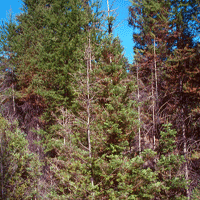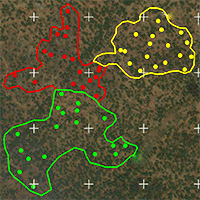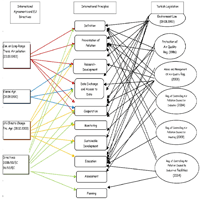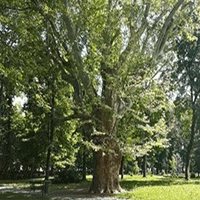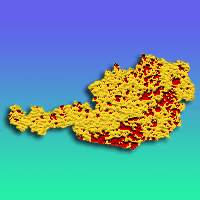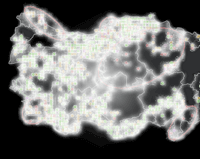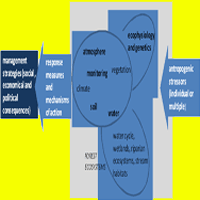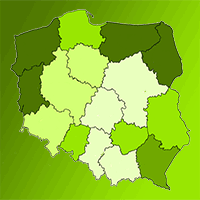
Contribution of anthropogenic, vegetation, and topographic features to forest fire occurrence in Poland
Mariusz Ciesielski (1) , Radomir Balazy (2), Boleslaw Borkowski (3), Wieslaw Szczesny (4), Michal Zasada (5), Jan Kaczmarowski (6), Miroslaw Kwiatkowski (7), Ryszard Szczygiel (7), Slobodan Milanovic (8-9)
iForest - Biogeosciences and Forestry, Volume 15, Issue 4, Pages 307-314 (2022)
doi: https://doi.org/10.3832/ifor4052-015
Published: Aug 23, 2022 - Copyright © 2022 SISEF
Research Articles
Abstract
Climate is one of the main causes of forest fires in Europe. In addition, forest fires are influenced by other factors, such as the reconstruction of tree stands with a uniform species composition and increasing human pressure. At the same time, the increasing number of fires is accompanied by a steady increase in the number and quality of spatial information collected, which affects the ability to conduct more accurate studies of forest fires. The appropriate use of spatial information systems (GIS) together with all the collected information on fires could provide new insights into their causes and, in further steps, allow the development of new, more accurate predictive models. The objectives of the study were: (i) to estimate the probability of fire occurrence in the period 2007-2016; (ii) to evaluate the performance of the developed model; (iii) to identify and quantify anthropogenic, topographic and stand factors affecting the probability of fire occurrence in forest areas in Poland. To achieve these objectives, a statistical model based on a logistic regression approach was built using the nationwide forest fire database for the period from 2007 to 2016. The information in the database was obtained from the Polish State Forest Information System (SILP). Then it was supplemented with spatial, topographic and socio-economic information from various spatial and statistical databases. The results showed that fire probability is significantly positively affected by population density and distance from buildings. In addition, the further the distance from roads and railways, watercourses and water objects or the edge of the forest, height above sea level, and steep slopes, the lower is the fire probability. Analysis of spatial, ecological and socio-economic factors provides new insights that contribute to a better understanding of fire occurrence in Poland.
Keywords
Forest Fires, Logistic Regression, Variables Selection, Anthropogenic Factors
Authors’ Info
Authors’ address
Department of Geomatics, Forest Research Institute, Sekocin Stary ul. Braci Lesnej 3, 05090 Raszyn (Poland)
Prevent Fires Foundation, Warszawa, ul. Drawska 29A/56, 02-202 Warszawa (Poland)
Department of Econometrics and Statistics, Institute of Economy and Finances, Warsaw University of Life Sciences - SGGW (Poland)
Department of Applied Informatics, Institute of Information Technology, Warsaw University of Life Sciences - SGGW (Poland)
Department of Forest Management, Dendrometry and Forest Economics, Institute of Forest Sciences, Warsaw University of Life Sciences - SGGW (Poland)
General Directorate of the State Forests, ul. Grójecka 127, 02-124 Warszawa (Poland)
Ryszard Szczygiel 0000-0001-8008-7430
Forest Fire Protection Laboratory, Forest Research Institute, Sekocin Stary, ul. Braci Lesnej 3, 05-090 Raszyn (Poland)
Chair of Forest Protection, University of Belgrade Faculty of Forestry, 11030 Belgrade (Serbia)
Department of Forest Protection and Wildlife Management, Faculty of Forestry and Wood Technology, Mendel University, 61300 Brno (Czech Republic)
Corresponding author
Paper Info
Citation
Ciesielski M, Balazy R, Borkowski B, Szczesny W, Zasada M, Kaczmarowski J, Kwiatkowski M, Szczygiel R, Milanovic S (2022). Contribution of anthropogenic, vegetation, and topographic features to forest fire occurrence in Poland. iForest 15: 307-314. - doi: 10.3832/ifor4052-015
Academic Editor
Davide Ascoli
Paper history
Received: Dec 29, 2021
Accepted: Jun 19, 2022
First online: Aug 23, 2022
Publication Date: Aug 31, 2022
Publication Time: 2.17 months
Copyright Information
© SISEF - The Italian Society of Silviculture and Forest Ecology 2022
Open Access
This article is distributed under the terms of the Creative Commons Attribution-Non Commercial 4.0 International (https://creativecommons.org/licenses/by-nc/4.0/), which permits unrestricted use, distribution, and reproduction in any medium, provided you give appropriate credit to the original author(s) and the source, provide a link to the Creative Commons license, and indicate if changes were made.
Web Metrics
Breakdown by View Type
Article Usage
Total Article Views: 29278
(from publication date up to now)
Breakdown by View Type
HTML Page Views: 24576
Abstract Page Views: 2872
PDF Downloads: 1421
Citation/Reference Downloads: 4
XML Downloads: 405
Web Metrics
Days since publication: 1207
Overall contacts: 29278
Avg. contacts per week: 169.80
Citation Metrics
Article Citations
Article citations are based on data periodically collected from the Clarivate Web of Science web site
(last update: Mar 2025)
Total number of cites (since 2022): 10
Average cites per year: 2.50
Publication Metrics
by Dimensions ©
Articles citing this article
List of the papers citing this article based on CrossRef Cited-by.
References
Les causes d’incendie: levons le voile [The causes of fire: let’s lift the veil]. Revue Forestière Français 42: 34-41. [in French]
Gscholar
Ekonometria. Wybrane zagadnienia [Econometrics. Selected issues]. Wydawnictwo Naukowe PWN, Warszawa, Poland, pp. 212. [in Polish]
Gscholar
Spatial distribution patterns of wildfire ignitions in Portugal. In: Proceedings of the “4th International Wildland Fire Conference”. Seville (Spain), 13-17 May 2007, Ministerio de Medio Ambiente, Seville, Spain.
Gscholar
Fire starts and human activities. In: “Towards Integrated Fire Management - Outcomes of the European Project Fire Paradox” (Silva J, Rego F, Fernandes P, Rigolot E eds). European Forest Institute, Joensuu, Finland, pp. 9-22.
Gscholar
Log-linear models and logistic regression. Springer, New York, USA, pp. 116-167.
Gscholar
Applied Regression Analysis. John Wiley and Sons, New York, USA, pp. 200.
Gscholar
A comparative analysis of different wildfire risk assessment models (a case study for Smolyan District, Bulgaria). European Journal of Geography 5: 22-36.
Gscholar
Modele zmiennych jakosciowych dwumianowych [Models of qualitative binomial variables]. In: “Mikroekonometria. Modele i analizy danych indywidualnych” [Microeconometry. Models and analyzes of individual data] (Gruszczynski M ed). Wolters Kluwer Polska, Warszawa, Poland, pp. 298. [in Polish]
Gscholar
Efekty interakcji miedzy zmiennymi objasniajacymi w modelu logitowym w analizie zróznicowania ryzyka zgonu [Interaction effects between predictor variables in a logistic model in an analysis of the diversity of death risk]. Przeglad Statystyczny 58 (1-2): 24-41. [in Polish]
Gscholar
Ocena dokladnosci modelu SRTM-X na obszarze Polski [Estimation of the accuracy of the SRTM model in Poland]. Archiwum Fotogrametrii, Kartografii i Teledetekcji 23: 139-145. [in Polish]
Gscholar
Ekonometria. Rozwiazywanie problemów z wykorzystaniem programu GRETL [Econometrics. Solving problems with the use of GRETL]. PWN, Warszawa, pp. 141. [in Polish]
Gscholar
Introduction to econometrics. John Wiley and Sons Ltd. New York, USA, pp. 381-383.
Gscholar
Land cover change and fire regime in the European Mediterranean Region. In: “Post-Fire Management and Restoration of Southern European Forests” (Moreira F, Arianoutsou M, Corona P, De las Heras J eds). Springer, Netherlands, pp. 21-43.
Gscholar
Forest fires in Europe, Middle East and North Africa. Publications Office of the European Union, Luxembourg, pp. 11.
Gscholar
Large-area forest fires in Poland. Bezpieczenstwo i Technika Pozarnicza 1: 67-78.
Gscholar
Forest fire risk estimation in Poland using geoinformatics methods. Teledetekcja Srodowiska (2014/2): 5-55.
Gscholar
Fire hazard and flammability of European forest types. In: “Post-Fire Management and Restoration of Southern European Forests” (Moreira F, Arianoutsou M, Corona P, De las Heras J eds). Managing Forest Ecosystems, vol. 24, Springer, Dordrecht, Netherlands, pp. 79-92.
CrossRef | Gscholar
Raport o stanie lasów w Polsce [Forests in Poland]. Centrum Informacyjne Lasów Panstwowych, Warszawa, Poland, pp. 90. [in Polish]
Gscholar

